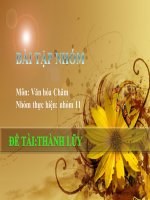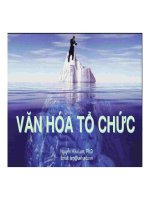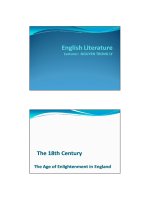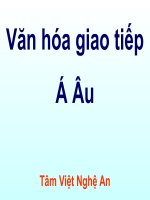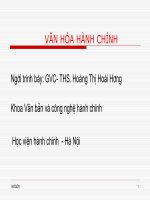Bài giảng Văn Hóa Anh
Bạn đang xem bản rút gọn của tài liệu. Xem và tải ngay bản đầy đủ của tài liệu tại đây (4.88 MB, 123 trang )
Historical Background
1.The Revolution of 1688.
2.Two parties: the liberal Whigs and the conservative
Tories came into being. However another party also
existed, the Jacobites, who aimed to bring the Stuarts back
to the throne.
3. The rapid development of social life
The public movement: the Enlightenment
The eighteenth-century England is also known as the
Age of Enlightenment or the Age of Reason. The
Enlightenment Movement was a progressive
movement which flourished in France and swept
through the whole Western Europe at the time.
The Enlightenment was an expression of struggle of
the progressive class of bourgeoisie against feudalism.
The movement was a furtherance of the Renaissance
of the fifteenth and sixteenth centuries. Its purpose
was to enlighten the whole world with the light of
modern philosophical and artistic ideas.
The enlighteners fought against class inequality,
stagnation, prejudices and other survivals of feudalism.
The enlighteners celebrated reason or rationality, equality
and science. They held that rationality or reason should be
the only, the final cause of any human thought and
activities. They called for a reference to order, reason and
rules.
They believed that when reason served as the
yardstick for the measurement of all human activities
and relations, every superstition, injustice and
oppression was to yield place to "eternal truth",
eternal justice" and "natural equality". The
enlighteners advocated universal education. They
believed that human beings were limited, dualistic,
imperfect, and yet capable of rationality and
perfection through education.
the great enlighteners
Famous among the great enlighteners in England were
those great writers are:
Alexander Pope
Joseph Addison
Sir Richard Steele
Jonathan Swift
Samuel Richardson
Daniel Defoe
Henry Fielding
Samuel Johnson
Literature
It is an age of prose rather than poetry. There are three
main divisions:
1. the reign of classicism
2. the revival of romantic poetry
3. the beginnings of the modern novels
Literal trends
The novel
neoclassicism
sentimentalism
pre-romanticism
Heroic couplet
The graveyard group
Gothic novel
Terms
1. Neoclassicism: a revival in the seventeenth and eighteenth centuries of
classical standards of order, balance, and harmony in literature. Alexander
Pope, John Dryden and Samuel Johnson were major exponents of the
neoclassical school.
It found its artistic models in the classical literature of the ancient Greek and
Roman writers like Homer, Virgil, Horace, etc. and in the contemporary
French writers such as Voltaire and Diderot. It put the stress on the classical
artistic ideal of order, logic, proportion, restrained emotion, accuracy, good
taste and decorum.
Homer: Greek epic poet. Two of the greatest works in Western literature,
the Iliad 《伊利亚特》 and the Odyssey 《奥德赛》, are attributed to him.
Virgil: Roman poet. His greatest work is the epic poem Aeneid, 《埃涅阿斯
纪》 which tells of the wanderings of Aeneas after the sack of Troy讲述了
埃涅阿斯在特洛伊陷落后的流浪经历.
Horace: Roman lyric poet. His Odes and Satires 《颂歌》 和 《讽刺作
品》 have exerted a major influence on English poetry.
Voltaire : French philosopher and writer whose works epitomize the Age of
Enlightenment, often attacking injustice and intolerance. He wroteCandide
(1759) and the Philosophical Dictionary (1764).
Diderot: French philosopher and writer whose supreme accomplishment
was his work on theEncyclopédie (1751-1772), which epitomized the spirit
of Enlightenment thought. He also wrote novels, plays, critical essays, and
brilliant letters to a wide circle of friends and colleagues.
Novel
2. Novel: a book-length fictional prose narrative, having many
characters and often a complex plot.
Character: it is an individual within a literary work. Characters
may be complex and well developed (round character) or
undifferentiated and one-dimensional (flat character) .
Protagonist: the central character of a drama, novel, short story,
or narrative poem. The protagonist is the character on whom
the action centers and with whom the reader sympathizes most.
Usually the protagonist strives against an opposing force, or
antagonist, to accomplish something.
Plot: the sequence of events or actions in a short story, novel,
play or narrative poem.
The Gothic Novel
3. The Gothic novel: the novel which exploits the possibilities
of mystery and terror in gloomy landscapes, decaying mansions
with dark dungeons, secret passages, instruments of torture,
ghostly visitations ghostly music behind which lurks no one
knows what as the central story, the persecution of a beautiful
maiden by an obsessed and haggard villain. The real originator
of English Gothic novel was Horace Walpole, with his famous
Castle of Otranto (1764) .
These novels rebel against the increasing commercialism and
rationalism opened up to later fiction the dark, irrational side of
human nature.
Epistolary Novel
4. Epistolary novel: a type of nnovel in which the
narrative is carried on by means of series of letters.
Samuel Richardson’s Pamela (1740) and Clarissa
Harlowe (1748) are among the best known epistolary
novels.
It can be classified into two kinds: the monologue
epistolary novel and the dialogue epistolary novel
Sentimentalism
5. Sentimentalism: is a literal movement in the
middle of the 18th century in England which
concentrates on the distressed of the poor unfortunate
and virtuous people and demonstrates that effusive
emotion was evidence of kindness and goodness. It
reveals grief, pains and tears. The representatives are
Laurence Sterne who wrote A Sentimental Journey
through France and Italy (1768) and Oliver
Goldsmith who wrote The Vicar of Wakefield (1766).
It came into being as a result of a better discontent on
the part of certain enlighteners in social reality.
Pre-romanticism
6. Pre-romanticism: a literal trend in the English
literature of the latter half of the 18th century which
composes the romance devoted to the medieval times.
William Blake and Robert Burns are two representatives
of pre-romanticists.
Daniel Defoe
Defoe's "Robinson Crusoe" was one of the forerunners of the
English realistic novel.
Adventures of Robinson Crusoe:The book is an expression of
the bourgeois qualities of individualism and private enterprise.
Robinson is a new man - a man sure of himself and sure of
being able to establish himself anywhere in the world. He is a
man of a new age, in which doubt and uncertainty are replaced
by hope and confidence. Robinson is the enterpriser of his age.
He is ready to command nature, his enemy, and to found his
colony beyond the seas. He is a merchant-adventurer,
interested in material profits. He is a colonist, the empire
builder.
Other works:Captain Singleton, Moll Flanders, Colonel
Jacque and Roxana. They clearly manifest Defoe's deep
concern for the poor in his society. They are the first literary
works devoted to the study of the problems of the lower-class
people.
Point of view
Defoe was a typical man of the eighteenth century English
middle class, hardworking, ingenious, liberal in mind and
advanced in opinion. He valued the Puritan ethic and belied in
diligence and self-reliance. All his life, he was busy,
speculative and active. He, like Robinson, is a man whose
personal pride would never allow him to belie his own
background and class. His works are reflections of the belief,
strength, weakness, interest, and morals of the bourgeois
middle class to which he belonged.
He was very sympathetic with those poor and less fortunate
and did everything he could to reach them and help them. He
was among the first writers ever to give concern to the
problems of the social outcast.
Jonathan Swift
Jonathan Swift (1667-1745), wrote satires in verse and prose.
He is best-known for the extended prose work Gulliver's
Travels, in which a fantastic account of a series of travels is the
vehicle for satirizing familiar English institutions, such as
religion, politics and law.
Early life and early works :During the time he wrote two works,
A Tale of a Tub and The Battle of the Books. They were
published together in 1704 and made him well-known as a
satirist. A Tale of a Tub is written in the form of a parable. The
phrase " a tale of a tub" was a 17th century slang for a joke, a
hoax, an idle discourse.
The Battle of Books is mainly an attack on pedantry in literary
world of the time. The two works established his name as a
satirist.
Pamphlets on Ireland
Swift's pamphlets on Ireland form a very important part of his
works. They have now become part of classic English literature.
Swift's life in Ireland gave him an intimate knowledge of the
miserable condition of the Irish people. Two of the most
famous ones are "The Draper's Letters“(1724) and "A Modest
Proposal“(1730). Gulliver's Travels(1726), as a whole, is one
of the most effective and devastating criticisms and satires of
all aspects in the then English and European life - socially,
politically, religiously, philosophically, scientifically, and
morally. Its social significance is great and its exploration into
human nature profound.
Analysis
Swift is one of the greatest writers of satiric prose. No
reader of his can escape being impressed by the great
simplicity, directness and vigor of his style.
Easy, clear, simple and concrete diction,
uncomplicated syntax, economy and conciseness of
language mark all his writings. Seldom is there
ornament or singularity of any kind. His simplicities,
more often than not, as a camouflage for insidious
intentions, for big serious matters,, and an outward
earnestness, simplicity, innocence and an apparently
cold impartial tone render his satire all the more
powerful and effective.
It is a book simple enough for a child, and yet
complex enough to carry an adult beyond his depth. It
is a satire on the 18th century english society,
touching upon the political, religious, legal, military,
scientific, philosophical as well as literary institutions,
about almost every aspect of the society. Bitterly
satirical, the book take great pains to bring to light the
wickedness of the then English society, with its
tyranny, its political intrigues and corruption, its
aggressive wars and colonialism, its religious disputes
and persecution, and its ruthless oppression and
exploitation of the common people.
Some narrative features
The novel is a fantasy ad a realistic work of fiction. The
language, as is typical of all Swift’s works, is very simple,
unadorned, straightforward and effective. It is noted for its
exceptionally tidy structural arrangement. The four
seemingly independent parts are linked up by the central
idea of social satire and make up an organic whole.
Some comments
While social exposure and satire of the book is
generally acknowledged, there have been great
controversies over its deeper intention, especially with
Part Four, What sort of thing is man? This is certainly
the central question to the book. Some people are
shocked by its open blunt “negativeness” towards
human beings, others feel satisfied with its religious
implication that, man in his development from
primitive forms of life, has achieved only a very
limited rationality and morality.
Samuel Richardson(1689
1761)
The accidental beginning of his literary career came in
1739 when, at the age of 51, Richardson was asked by
two bookseller friends to compile a volume of model
letters for people without much formal education to
practice in their correspondence. Richardson intended
that his manual should not only teach people how to
write letters but also be morally instructive. He was
duly rewarded for his kindness and the pain he had
taken for the composition of such moving letters.
His works:
Pamela (1740-1741)
Or (Virtue Rewarded, in a Series of Familiar Letters
from a Beautiful Young Damsel to Her Parents)
Clarissa Harlowe (1747)
Or: Virtue Triumphant
Sir Charles Grandison (1753-1754)
He wrote only three novels, all in epistolary form.
Henry Fielding(1707 1754)
Fielding was a man of extraordinary vitality and
capacity. He was a dramatist, an essayist and a
novelist. His fame is established chiefly upon his
success as a novelist. Joseph Andrews (1742), his first
novel .
The History of Jonathan Wild the Great (1743)
The History of Tome Jones, A Foundling (1749) , his
masterpiece.
In both theory and practice, Fielding establishes once
and for all the from of the English novel. He has held
a unique position in the history of English literature
by being called the “father of the English novel
”, for
his contribution to the establishment of the form of
modern novel. Fielding set up the theory of realism in
literary creation. He wrote specifically "comic epic in
prose", the first to give the modern novel its structure
and style.
Before him, the relating of a story in a novel was
either in the epistolary form (a series of letters) as in
Richardson's Pamela, or the picaresque form
(adventurous wanderings ) through the mouth of the
principal character, as in Defoe's Robinson Crusoe,
but Fielding adopted "the third-person narration". In
planning his stories, he tries to retain the grand epical
form of the classical works but at the same time keeps
faithful to his realistic presentation of the common life
as it is.
Tome Jones
As one of the pioneers of English realistic literature,
Fielding portrays the real life of men without disguise.
He exposes the hypocrisy and depravity of the ruling
class, and pictures the poverty of the working masses
who are driven by want to crime. For a time, Tom
became a national hero. People were fond of this
young fellow with manly virtues and yet not without
fault. The full-blooded characters are realistically
depicted in brilliant, witty and highly artistic language.
Tom Jones is a handsome young man. He is frank and open.
His outstanding quality is "good nature" and "goodness of
heart". He is never an indifferent spectator of the misery or
happiness of anyone. He would not willingly inflict even the
most trifling harm on anybody. Yet Tom is very far from being
a model character. He lives by impulse, not by reason. The
most serious mistake that Tom commits is his liaison with
Lady Bellaston after his arrival in London. A simple country
boy thoroughly ignorant of the ways of the depraved high
society in London, he is completely taken by surprise by a bad
woman and becomes, for a short time , her paid lover. But as
soon as he learns the true character of the woman , he
immediately terminates the connection.
Sophia was Fielding's ideal of what an amiable English
girl should be. But he did not make her "perfectly perfect'.
Though very sweet-tempered, she can flame up into an
angry passion on occasions. She has also a little vanity
which causes her to toy with the idea of playing the part of
a tragic heroine, sacrificing herself to her father's wishes.
William Blake(1757 1827)
His life story (Page 283-284)
His position in English literature: the representative of
pre-romanticist.
His main works:
Songs of Innocence (1789)
The Marriage of Heaven and Hell(1790)
Songs of Experience (1794)
Appreciate the poem London on P.287
Robert Burns(1759 1796)
His life story (P.P 290 293)
The greatest of the 18th century Scots poet.
His works:
Poems, Chiefly in the Scottish Dialect
The Tree of Liberty
My Heart’s in the Highland (Page 294)
A Red, Red Rose (Page 295)
Hyperbole
I am hungry as a horse.
You run like a rabbit.
He is sneaky as a snake.
She is happy as a clam.
The girl was a fish in the water.
The clown was a feather floating away.
The flowers danced in the wind.
The Earth coughed and choked in all of the
pollution.
The friendly gates welcomed
us.
Stan the strong surfer saved several
swimmers on Saturday.
Tiny Tommy Thomson takes toy
trucks to Timmy’s on Tuesday.
Princess Kitty will kiss
Timmy T. Tippers’s lips
The pain may drain Drake, but maybe the weight is fake.
